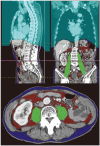The Kagoshima-DVT Score Is a Useful Predictive Model for Cancer-Associated Thrombosis in Patients With Gastrointestinal Cancer
- PMID: 36818519
- PMCID: PMC9908526
- DOI: 10.1253/circrep.CR-22-0112
The Kagoshima-DVT Score Is a Useful Predictive Model for Cancer-Associated Thrombosis in Patients With Gastrointestinal Cancer
Abstract
Background: Cancer-associated thrombosis (CAT) is a common complication of cancer and has received increasing attention; the Khorana Risk Score (KRS) is a recommended but insufficient risk assessment model for CAT. We propose a novel Kagoshima-DVT score (KDS) to predict preoperative deep vein thrombosis (DVT). This scoring method scores D-dimer ≥1.5 μg/mL, age ≥60 years, female sex, ongoing glucocorticoids, cancer with high risk of DVT, and prolonged immobility. The purpose of this study was to compare the performance of the KDS and KRS in predicting CAT in patients with gastrointestinal cancer. Methods and Results: In all, 250 patients without a history of thrombosis who received their first chemotherapy for gastrointestinal cancer were divided into low- (48.0%), intermediate- (38.8%), and high-risk (13.2%) groups for CAT development by the KDS. The patients' median age was 67 years and 63.2% were men. In all, 61 (27.1%) patients developed CAT (17.6%, 35.3%, and 36.4% of patients in the low-, intermediate, and high-risk groups, respectively; log-rank P=0.006). The area under the time-dependent receiver operating characteristic curve for CAT occurrence within 1 year was larger for the KDS than KRS (0.653 vs. 0.494). Conclusions: A high KDS at the start of first chemotherapy is a risk indicator for CAT development during chemotherapy. Moreover, the KDS is more useful than the KRS in predicting CAT risk.
Keywords: Cancer-associated thrombosis; Kagoshima-DVT score; Khorana risk score.
Copyright © 2023, THE JAPANESE CIRCULATION SOCIETY.
Conflict of interest statement
The authors have no conflicts of interest directly relevant to the contents of this study to declare. M.O. is a member of Circulation Reports’ Editorial Team.
Figures





References
-
- Comfere TB, Sprung J, Case KA, Dye PT, Johnson JL, Hall BA, et al.. Predictors of mortality following symptomatic pulmonary embolism in patients undergoing noncardiac surgery. Can J Anaesth 2007; 54: 634–641. - PubMed
-
- Hamamoto Y, Tokushige A, Toshinori Y, Ikeda Y, Horizoe Y, Yasuda H, et al.. A new pre-test probability score for diagnosis of deep vein thrombosis in patients before surgery. J Cardiol 2022; 79: 664–670. - PubMed
-
- Timp JF, Braekkan SK, Versteeg HH, Cannegieter SC.. Epidemiology of cancer-associated venous thrombosis. Blood 2013; 122: 1712–1723. - PubMed
LinkOut - more resources
Full Text Sources
Miscellaneous

